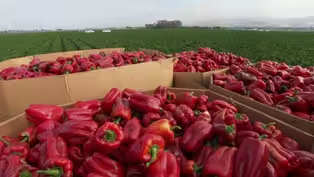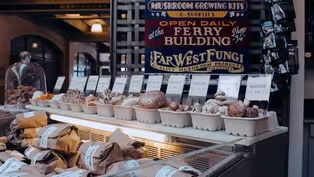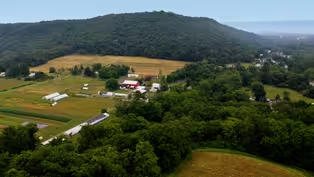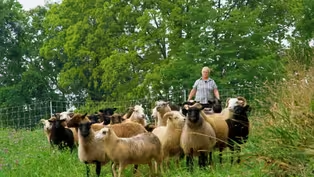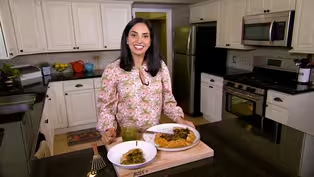
Episode 1
7/1/2023 | 26m 46sVideo has Closed Captions
Visit an indoor mushroom farm and learn how to cook a wild mushroom galette.
A mushroom farm near Monterey Bay grows unique varieties like Lion’s Mane and Cauliflower mushrooms. Discover how to prepare a Wild Mushroom Galette with chimichurri sauce. Visit a bustling farm in California’s Central Valley as they harvest bell peppers. Meet the women who own a rural farm in Pennsylvania that’s a leader in organic and sustainable agriculture.
Problems playing video? | Closed Captioning Feedback
Problems playing video? | Closed Captioning Feedback
America's Heartland is presented by your local public television station.
Funding for America’s Heartland is provided by US Soy, Sustainable Agriculture Research and Education, Rural Development Partners, and a Specialty Crop Grant from the California Department of Food and Agriculture.

Episode 1
7/1/2023 | 26m 46sVideo has Closed Captions
A mushroom farm near Monterey Bay grows unique varieties like Lion’s Mane and Cauliflower mushrooms. Discover how to prepare a Wild Mushroom Galette with chimichurri sauce. Visit a bustling farm in California’s Central Valley as they harvest bell peppers. Meet the women who own a rural farm in Pennsylvania that’s a leader in organic and sustainable agriculture.
Problems playing video? | Closed Captioning Feedback
How to Watch America's Heartland
America's Heartland is available to stream on pbs.org and the free PBS App, available on iPhone, Apple TV, Android TV, Android smartphones, Amazon Fire TV, Amazon Fire Tablet, Roku, Samsung Smart TV, and Vizio.
Providing Support for PBS.org
Learn Moreabout PBS online sponsorshipComing up on America's Heartland...
Discover how mushrooms are grown and harvested at a family-owned mushroom farm near California's Monterey Bay.
Through farmers markets and retail stores, these farmers aim to educate their customers by introducing them to fun and unusual mushroom varieties.
[Toby Garrone] I find that people are a lot more adventurous than I think they would be in the grocery store.
Join Farm to Fork host Sharon Profis as she prepares a wild mushroom galette.
From the flaky crust to the mushroom filling, she'll walk you step-by-step through this savory dish.
[Sharon] Look at that beautiful, beautiful mushroom filling.
Plus, it's harvest time for this much-loved specialty crop!
We visit this bustling farm as they pick and pack bell peppers, and learn why California is a top grower of these popular green and red varieties.
[Briana Giampaoli] The climate is ideal for pepper growing.
And meet the women behind Village Acres Farm.
They've become leaders in sustainable agriculture and organic farming in central Pennsylvania.
See what methods they're using to protect the soil and water on their land.
It's all coming up on America's Heartland!
America's Heartland is made possible by... ♪♪ ♪ You can see it in the eyes of every woman and man ♪ ♪ in America's heartland, living close to the land.
♪ ♪ There's a love for the country and a pride in the brand ♪ ♪ in America's heartland, living close, ♪ ♪ close to the land.
♪ ♪♪ Now, this may look like lobster, but it's not.
And this cauliflower?
Well, it's not cauliflower, but a mushroom called Lion's Mane.
Lion's Mane is really cool for kind of, like, imitating meat.
So, you can kind of cut really thick slices of it and almost do, like, a crab cake out of it.
Some people will bread them up and fry them.
So, you get this, like, nice crispy texture on it.
The distinctive looking "lobster" and "cauliflower" are just two of the organic, exotic mushroom varieties that customers can find at the Far West Fungi Café in Santa Cruz, California.
[Ian Garrone] They're usually, um, just really intrigued with the variety that we bring in.
Maybe the only thing they've ever had is a... is a white button mushroom that came in a can and how much they dislike those mushrooms.
And then, when they come to our shop, they realize, well, it's not the only thing that is available.
We do have some, uh, new merchandise that's going to be coming in.
It looks like, uh, on... online sales have been really good... Ian Garrone oversees operations for Far West Fungi's Santa Cruz store and the company's outlet in San Francisco's Ferry Building.
The family-run agricultural operation- with Ian, his parents and three brothers- also provides online sales and reaches consumers directly at more than a dozen farmers markets in Northern California.
Many shoppers are attracted to the exotic mushroom varieties seldom found elsewhere.
♪♪ [Ian] Well, they love the product.
You know, usually they say, "I haven't...
I haven't been able to find this for years," or, you know, "This was a mushroom that I only found in my native country," whether it be the Philippines or, you know, Russia.
Ian's parents, John and Toby Garrone, began the business in the 1980s.
John came from a farming background.
Living in San Francisco, the couple began growing mushrooms in a warehouse as a sideline to John's full-time job.
[John] When I started working in the mushroom business, um, I was still a member of the communications staff of the San Francisco Police Department.
And so, basically, I was, uh, dispatching police cars at night, and then selling mushrooms in the morning.
Far West raises their organic, exotic mushroom varieties at two locations south of San Jose in California's coastal area.
The majority are raised here in an extensive warehouse complex near Moss Landing.
[Kyle Garrone] So, you can actually grow mushrooms anywhere, um, all over the world because you're basically having mushroom houses that are temperature and humidity controlled.
Ian's brother, Kyle Garrone, handles operations here, a complex process involving detailed steps unlike other types of agricultural production.
That's because mushrooms are their own organism- neither plant nor animal.
Mushrooms draw nutrients from their environment and don't need sunlight to flourish.
[Kyle] So, it's very different than any type- other type of agricultural product.
Um, it's somewhere in between, like, farming and science, um, and somewhat like a factory, because you're producing it in large volumes in big warehouses.
♪♪ Far West grows their fungi in organic hardwood sawdust.
After an aging fermentation period, nutrients are added to supplement the sawdust and the combination moves through a mixing machine to be packed into large bags.
From there, these bags of hardwood growing material called "substrate" are off to be sterilized in large boiler-like ovens called autoclaves.
[Kyle] And so, we will sterilize them at 121 Celsius or 250 degrees Fahrenheit, um, for about four hours to eliminate all the life in the material.
From there, the bags go to a "clean room," where the substrate is inoculated with something called mycelium, different strains of which determine the dozen plus exotic varieties of mushrooms raised here.
[Kyle] So, we'll be adding that to our bags and then we seal the bag.
And so, we're basically sealing the fungus within its food source in a sterile environment.
So, it's basically, you have your fungus with its food without any competition, and that will allow that mushroom to grow and develop without having any issues of different diseases coming into- to our substrate.
The bags of inoculated substrate are stored in dark humid environments where the mushrooms, sprouting from the substrate, are harvested by hand.
Far West will process more than 20,000 bags a week.
From the beginning, farmers markets have been key to the family's success, as customers looking to expand their food horizons sampled and purchased new varieties.
[Toby] Farmers markets are really important.
I find that people are a lot more adventurous than I think they would be in the grocery store.
I think that we were so lucky as to when we started and just... just the movement of food and fresh food, organic food, uh, healthy food has- You know, we just came into it by luck at the right time.
Ian Garrone hopes his young daughters can someday carry on this farming family tradition, a tradition that he says uses everyone's talents to the best advantage.
[Kyle] So, we have our- all our strengths, uh, you know, kind of covered, um, but everyone does different things.
And I think that really helps, um, allow us to kind of grow in our own areas, and then also can support each other.
♪♪ Take your pick!
There are several thousand varieties of mushrooms growing in the United States, but only a few hundred are thought to be safely edible.
And a word about Toadstools: The word was once used interchangeably by some cultures in identifying certain mushrooms.
Today, the word toadstool is often used to describe examples of poisonous mushrooms.
♪♪ ♪♪ Today, we're making a wild mushroom galette.
It is a pretty simple recipe, even for non-bakers.
First, I'll add one and a half cups of all purpose flour to a food processor.
In this case, I'm adding salt and pepper because this is a savory crostata, and I want that flavor to come through.
I'm also going to have a little fun with it and add some herbs to the crust.
We'll go ahead and give that a few pulses.
Going to add all of these pieces of butter right in there.
I have about half a cup of ice water here.
I'm going to add just as much as is needed to bring the dough together.
If it comes together like that, you are all set.
So, let's go ahead and dump this out onto the cutting board, get our dough into a disk, and then we'll chill it for about an hour in the fridge.
Now, I'll cover it with some plastic wrap.
And what will happen in the fridge during that hour is the flour will continue to absorb that moisture.
Now, let's get started on that wild mushroom filling.
We're going to lightly caramelize onions.
And to that, I'll add a tablespoon of butter and just a little bit of olive oil.
Now, we'll leave those be while we prepare our mushrooms.
We have three types of mushrooms.
I have cremini mushrooms.
We also have oyster mushrooms.
And then, we have maitake mushrooms, which are also known as hen-of-the-woods mushrooms.
So, you want about 20 to 24 ounces of mushrooms here with about a pound of that being the cremini mushrooms.
Our onions are exactly where we want them to be, so let's go ahead and add our mushrooms.
We're adding what looks like a lot of mushrooms to this pan, but mushrooms lose a ton of moisture when they cook.
So, what looks like a lot will end up being just the right amount for our galette.
I'll also, at this point, add some salt and a few cracks of pepper.
We'll sauté these until the mushrooms have shrunk and released most of their moisture.
The mushrooms have a little bit of browning on some of them, so we want to add our final ingredients.
I'm going to add four cloves of garlic grated right into the pan.
I also want to add some thyme.
Give that a rough chop.
And I'm also going to deglaze the pan with about a tablespoon of balsamic vinegar and it'll add just a little bit of that tart, sweet flavor that'll round out this filling.
Let's put together our galette.
Our dough has been resting in the fridge for about an hour.
We want to roll it out to a 14 inch circle.
I am actually going to go ahead and transfer this to a baking sheet and stick it in the freezer.
Now, let's finish up our filling.
So, we have our mushrooms and onions that have cooled here.
I also have about a cup of shredded fontina cheese.
That's it.
Our filling is ready, and now it needs to go inside the crust.
I'm leaving about one to two inches of a border here.
And now, we'll fold this over.
I'm just giving a little gentle pinch around the edges here.
I'll sprinkle the remaining cheese right on top.
I also like to let it kind of go over the crust a little bit.
And the final step is to get an egg wash on this crust so that it browns beautifully.
Then, it'll go into the oven at 400 degrees for about 45 minutes.
Then, we'll take it out and let it rest for about 20 minutes.
In the meantime, let me show you how to make chimichurri sauce to go with this recipe.
To make chimichurri, you'll need one bunch of cilantro, half a bunch of parsley, two tablespoons of red wine vinegar, half a chopped shallot, half a cup of olive oil, and salt, pepper and a pinch of paprika.
The rest is simple.
Add all the ingredients except for the olive oil to a food processor.
Then, while the motor runs, drizzle in the oil.
Depending on how many herbs you added, you may need to add a little more oil and vinegar to get that smooth consistency.
Finally, transfer your chimichurri to a jar and keep it in the fridge for five to seven days.
Our galette is out of the oven.
It has cooled for about 20 minutes, and now we're ready to slice into it.
The crust has gotten this beautiful golden brown color.
It's also nice and flaky, just how we wanted it.
Look at that beautiful, beautiful mushroom filling.
I love that with a galette, it goes all the way to the very edge, and then you get that nice fold of crust right on top.
You can see we have a nice flaky crust.
And we've made that chimichurri sauce.
The brightness of the chimichurri sauce, thanks to the acidity of the, uh, vinegar, just goes so, so well with this dish.
And now, all that's left to do is eat.
♪♪ Still ahead on America's Heartland... Join us as we visit a women-owned, organic farm in Pennsylvania.
We'll show you what practices they've put in place to make Village Acres Farm a sustainability leader in their region.
But first... Bell peppers are a popular food in the United States, enjoyed fresh, stuffed, or as a topping on pizzas.
We visit Live Oak Farms in California's Central Valley as they harvest and pack a variety of bell peppers fresh off the farm!
♪♪ Under the warm California sun, on more than 2,000 acres of land, rows and rows of green and red bell peppers have found the perfect place to grow and thrive.
[Briana Giampaoli] California, I mean, the climate is ideal for pepper growing.
Briana Giampaoli, her brother Dominic and their father, Bob, are the third and fourth generation of farmers who own Live Oak Farms in Le Grand, California.
[Dominic] I'm the farm manager for most of the vegetable crops, um, throughout many of the different regions for Live Oak Farms.
Bob's sister, Sandy, also works here running the main office, but it's out in these fields in California's Central Valley where Live Oak Farms first started, thanks to their ancestors who came from Italy in 1926 and planted their first tomato crop.
[Sandy] They, um, researched and I guess decided Le Grand was a good place to grow their tomatoes and they must have brought their seeds.
Later, they began growing almonds, jalapeños, corn, eggplant, and bell peppers.
The family soon learned how well peppers adapt to the California climate.
Eventually, they were able to make the most of regional temperature changes to grow peppers throughout the year.
[Dominic] So, we grow in many different regions, pretty much, um, so we extend our season and... and just different areas of California are better for our crops, um, just because of the weather patterns that go throughout California.
Here in Le Grand, they're able to grow peppers three months out of the year.
When it's too hot here, it's just right farther west in the coastal area of Gilroy.
In the Southern California regions of Coachella and Bakersfield, they can plant earlier because it gets hotter sooner.
Farming in four different regions allows the family to harvest peppers nine months out of the year.
[Dominic] As we continue to push the boundaries and extend our crops into different areas, um, make it a year-round process is the goal.
♪♪ Today is harvest day in the Gilroy fields, where crews work alongside a mechanized belt to hand-pick bell peppers.
[Dominic] They pretty much pick a basket of bell peppers, put it on the belt.
It gets shifted over to a tractor that's carrying six bins in a trailer behind it.
Workers carefully dump the peppers into the bin to make sure there's no bruising.
Red peppers are hand-packed in the field, while green ones are sent to the packing shed in Le Grand, where they're processed.
[Briana] Once it gets to the packing shed, they are washed, they are sorted.
So, wanting to take out all the defective peppers, the ones that aren't desirable to consumers or to our buyers.
Then, they go down a packing line, where the machinery inspects each pepper again for defects and shoots them to the appropriate box.
The boxes are stacked and sent to the cooler to await shipping trucks.
Those trucks deliver Live Oak Farm's produce throughout the U.S. and Canada.
[Briana] Look for it in grocery stores, at- You'll- I'm sure you're eating them at restaurants, which is really great, at least for me, you know, as a farmer, to know that we are helping feed America.
That's one reason the Giampaolis say they want to continue the family tradition of farming, despite the many challenges facing farmers in California.
[Bob] The biggest challenges, I think, are- at the top of the order, would be labor and... and regulations in... in California.
It just gets harder and harder.
All of their vegetables are hand-harvested.
So, as labor costs go up, production costs go up.
When they don't have enough workers, they fall behind and risk losing produce that sits unharvested in the field.
The other big problem they face is with California's ongoing drought.
[Dominic] We're going to soon have restrictions on pumping water.
Um, so, years when there is a drought, uh, or we don't have as much rain, the pumps are going to be limited to what we can grow.
So, we're going to have to do more with less acres.
[Briana] With lack of water, if we're not able to give tomatoes, bell peppers, the amount of water that is needed to grow, we're going to see differences in- whether it be fruit size or... or volume or, you know, all... all across the board.
Considering all of the challenges, Bob Giampaoli encouraged his kids to leave the farm for college and come back only if they're passionate about farming and dedicated to finding solutions to these big challenges.
[Bob] I'm...
I'm glad they're back.
And, you know, they're... you know, they're a big push of it now, 'cause it's not getting any easier, you know, in this day and age.
Briana and Dominic both say they can't imagine doing anything else.
[Briana] I've really asked myself that question, like, "What else would you do?"
And I can't find an answer, which makes me believe I'm exactly where I'm supposed to be.
I love growing the product.
I love working with my family.
[Dominic] It's something I knew from a young age.
You either like it or you don't.
Um, and I've always loved being out in the fields.
[Briana] It's a hard job.
It's not for everyone.
A lot of hours, a lot of, you know, sleepless nights.
This family says they're still driven by a passion for farming, for working with family and, ultimately, a desire to grow a quality product that would make their great grandparents proud.
Both generations hope to continue a family tradition that includes feeding the community and caring for their land.
[Dominic] To me, it's to maintain the goal that I think, you know, my great grandparents started, and it was to keep a family farming business going for generations to come and, um, to just keep growing and... and keep giving the next generation something to look forward to coming back home to.
♪♪ Here's a fun fact about bell peppers: Most people think bell peppers are a vegetable, but they're actually a fruit!
They're produced from a flowering plant and come from the same family as tomatoes and eggplants.
Green bell peppers are the most popular variety in the United States, but you'll also commonly find yellow, orange and red peppers.
The fruit changes color as it ripens on the vine.
So, a red bell pepper is actually a very ripe green bell pepper!
As the fruit ripens, the sugar content increases, making the red bell pepper the sweetest variety.
♪♪ [Debra Brubaker] From a very early age, I was working in the fields with my parents.
My dad grew up on a farm about eight miles from here, and his father was an organic farmer.
My grandfather kind of stayed true to organic practices and very much influenced my dad in that way.
Everywhere you look, you'll see the influence of Debra's father and grandfather on these 75 acres of land.
It's called Village Acres Farm, and it's known in central Pennsylvania for being a leader in sustainability.
Today, the farm is run by Debra Brubaker and her wife, Hannah Smith-Brubaker.
Debra's sisters, Phoebe and Angela Brubaker, also run a commercial flower business on the farm, making this a true family affair.
[Debra] We have crop land- about five to seven acres of... of vegetable crops- as well as, uh, doing pastured livestock.
[Hannah] We grow about 50 different varieties of vegetables, um, and the breed of sheep that we raise is Shetland, which is traditionally from Scotland.
They do a really good job in everything from weed control to returning nutrients to the soil.
In the early days, Village Acres Farm was a place where customers could pick their own berries.
At other times, the farm offered Community Supported Agriculture, or CSA, boxes.
Today, they mostly sell their produce at local restaurants.
Debra says she and her siblings were raised by parents who believed that farming was a higher calling.
[Debra] I think it's the fusion of my dad's real interest in farming with my mom's love of birds, flowers, everything, to really kind of create a property that really looks out for... for both food for humans, as well as... as the natural environment.
[Phoebe] We know that mom and dad really wanted it to be a place that fed other people, not just food, but also valuable relationships.
And so, we've been sort of, um, looking at how flowers are integrated.
The flowers bring in a new income stream, and just as important, they're good for the crops.
[Hannah] So, we've added a lot of flowers to our farm, which is great because that's a great enterprise, but at the heart of it, we can grow better vegetables attracting the bees.
The family has made other changes to increase sustainability on the land.
They planted 3,000 native trees, creating a buffer along the creek.
That buffer prevents soil from washing into the creek when it rains.
[Hannah] We want that soil to stay in the fields.
And so, we've been working with farmers, um, for a couple of years now to establish trees along the creek on their farms, so that it's cleaner water when it comes our way to our farm.
[Debra] So, these are the paprika peppers, two different varieties.
[Hannah] For true sustainability, we focus on three areas: people, planet and production or profitability.
When it comes to people, we want to make sure that we have a good quality of life here on our farm and that we're also economically supporting our local community.
In terms of the earth, we want to make sure that we can continue to grow food well into the future.
So, we want to pay attention to things like soil health and water quality.
And then, profitability or production.
Well, in order to make it as farmers, we have to be profitable.
While Village Acres Farm is notable for its sustainability practices, they say there's something else that sets them apart.
[Debra] Well, honestly, I think what's probably makes us most notable is that we're a bunch of women on this farm.
So, right now, all my mother, the three of my siblings, my partner, who's also a woman, um, is... is sort of what identifies us to the... to the larger community.
[Hannah] In the end, we're really a united force.
We know that we want to feed people, that we want to create a beautiful and ecologically sound environment.
And that takes all of us.
♪♪ Pennsylvania ranks third in the nation when it comes to organic product sales.
The state is consistently in the top five states for organic mushrooms, eggs, turkeys and dairy cows.
That's contributed more than $1 billion to Pennsylvania's economy, with demand only increasing, fueled in part by the state's close proximity to major markets like Philadelphia, New York and Washington, D.C. That's it for this edition of America's Heartland.
For more stories, full episodes and recipes, visit americasheartland.org or connect with us on Facebook.
♪ You can see it in the eyes of every woman and man ♪ ♪ in America's heartland, living close to the land.
♪ ♪ There's a love for the country and a pride in the brand ♪ ♪ in America's heartland, living close, ♪ ♪ close to the land.
♪ America's Heartland is made possible by... ♪♪
Video has Closed Captions
Clip: 6/30/2023 | 6m 20s | Visit a bustling farm in California’s Central Valley as they harvest bell peppers. (6m 20s)
Video has Closed Captions
Clip: 6/30/2023 | 6m 2s | A mushroom farm near Monterey Bay grows unique varieties. (6m 2s)
Video has Closed Captions
Preview: 6/30/2023 | 30s | Get ready for an all-new season of America’s Heartland premiering July 1! (30s)
Sustainable Agriculture in Pennsylvania
Video has Closed Captions
Clip: 6/30/2023 | 5m | Meet the women who own a rural farm in Pennsylvania. (5m)
Wild Mushroom Galette – Farm to Fork with Sharon Profis
Video has Closed Captions
Clip: 6/30/2023 | 5m 33s | Discover how to prepare a Wild Mushroom Galette with chimichurri sauce. (5m 33s)
Providing Support for PBS.org
Learn Moreabout PBS online sponsorshipSupport for PBS provided by:
America's Heartland is presented by your local public television station.
Funding for America’s Heartland is provided by US Soy, Sustainable Agriculture Research and Education, Rural Development Partners, and a Specialty Crop Grant from the California Department of Food and Agriculture.
